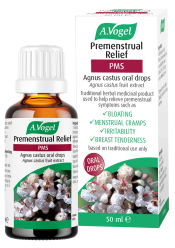60 seconds in menopause video transcript:
Why are perimenopausal periods so painful? Because oestrogen levels can spike in the late forties and early fifties before they start to fall, creating an imbalance between oestrogen and progesterone levels, called oestrogen dominance. So, it can create PMS symptoms that weren't there before, or it can worsen existing painful periods (and other PMS symptoms).
Gentle stretching exercises and walking can ease muscle tension that caused the cramps. And it's really important to address any constipation issues that can worsen period pains. Increasing magnesium in the diet can help with painful muscle cramps. Good sources are wholegrain foods like brown bread, dried fruit, nuts, seeds, and green veg. Or you could top up with a supplement.
Agnes castus is a herbal remedy that can be used to relieve the symptoms of PMS, providing you are not on hormonal contraceptives such as the pill or the Mirena coil.
For more information and advice head over to Eileen's blog 'Perimenopause periods: what's normal and what's not?' where she outlines what you can expect when it comes to your periods during perimenopause, including what's normal changes and what is not normal.
You may also find these topics helpful:
What are the signs that perimenopause is ending?
10 self-care tips for perimenopause, menopause & postmenopause









